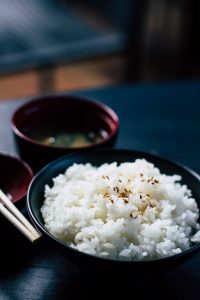




What types of rice are better.
Short-grained white rice definitely should be cut from the diet. It’s refined, has a high GI that’s higher than 69 and less nutrition than other types of rice or even starches. Brown rice, long grain rice and wild rice are better. They all have a GI between 56-69. Wild rice isn’t really rice. It’s the grain from a semi-aquatic grass that grows prolifically in the Great Lakes region of the U.S. White rice is highly processed, unlike it’s counterpart brown rice, which has more nutrients. Basmati rice, also known as long grain rice, also has a lower GI rating. The brown basmati is best because it’s higher in fiber, that slows the absorption of carbs.
How the rice is processed makes a difference.
Parboiled rice is healthier, compared to traditional white rice. White rice is milled, which removes the husk, germ and bran, which gives it a different flavor. Parboiled rice uses a different process. It’s partially boiled in its husk, which is done by soaking, steaming and drying. That allows the nutrient value to be boosted, making it much like that of brown rice. Don’t confuse it with instant rice, which is white rice precooked and dried.
How you cook rice makes a difference.
If you boil white rice, refrigerated and then used cold, as in salads, the GI is also lower, so much lower that it falls into a lower GI category of low GI-foods. That occurs because the cooking and cooling changes how easily the starch is digested. You can make it into a salad, such as a Mexican bean and rice salad with black beans, corn, kidney beans, onion, lime juice, cilantro and red bell pepper. It’s a healthy way to eat rice and with the protein, a good main dish.
- If you want a vegetarian main dish containing rice that has a lower GI, try red beans and rice using parboiled or brown rice. They are a complete protein and the beans lower the rice’s GI.
- If you want a substitute for rice with a lower GI—under 55, try wild rice, quinoa or pearl barley. The taste and texture are about the same, but it provides more nutrients and variety.
- Studies on the effect of white rice compared to brown rice have shown to be beneficial for prediabetes and diabetes. The fiber in brown rice may be the reason and the increased nutrition is good for everyone, diabetic or not.
- You can eat rice if you’re diabetic, but limit the amount you eat and use the brown, parboiled variety if possible. Focus on variety, a healthy diet and finding alternatives or ways to make the rice have a lower GI rating.
For more information, contact us today at Travel Trim
